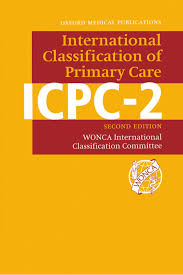The International Classification of Primary Care (ICPC) is a classification method for primary care encounters. It allows for the classification of the patient’s reason for encounter (RFE), the problems/diagnosis managed, primary or general health careinterventions, and the ordering of the data of the primary care session in an episode of care structure

It was developed by the WONCA International Classification Committee (WICC), and was first published in 1987 by Oxford University Press (OUP). A revision and inclusion of criteria and definitions was published in 1998. The second revision was accepted within the World Health Organization's (WHO) Family of International Classifications.
The classification was developed in a context of increasing demand for quality information on primary care as part of growing worldwide attention to global primary health care objectives, including the WHO's target of "health for all".
The ICPC contains 17 chapters:
- A General and unspecified
- B Blood, blood forming organs, lymphatics, spleen
- D Digestive
- F Eye
- H Ear
- K Circulatory
- L Musculoskeletal
- N Neurological
- P Psychological
- R Respiratory
- S Skin
- T Endocrine, metabolic and nutritional
- U Urology
- W Pregnancy, childbirth, family planning
- X Female genital system and breast
- Y Male genital system
- Z Social problems